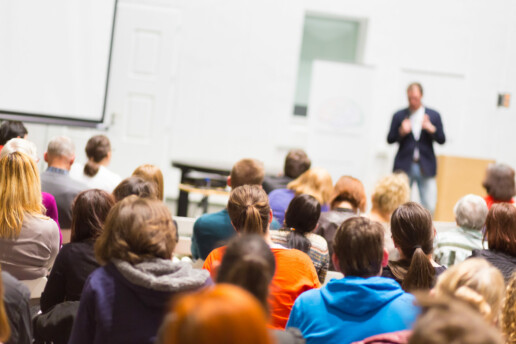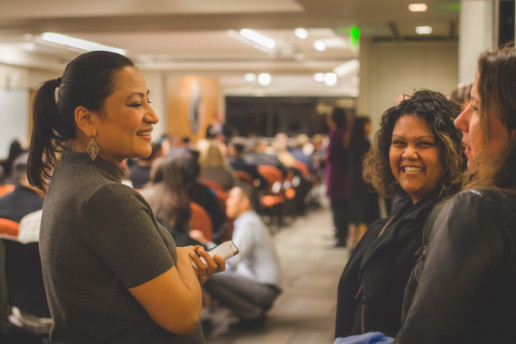Guest Post: Moving Legal Education to the Fourth Dimension
 Guest Post: Moving Legal Education to the Fourth Dimension
Guest Post: Moving Legal Education to the Fourth Dimension
Deborah Jones Merritt
Distinguished University Professor
John Deaver Drinko-Baker & Hostetler Chair in Law
Much of law school is two-dimensional, confined to the written pages of statutes, regulations, and appellate decisions. Clients appear in our classroom hypotheticals and final exams, but they are cardboard figures designed to illustrate a point or test a legal concept. These cut-out clients lack the backstories, personalities, and secrets that three-dimensional clients embody. Nor do these cardboard clients change their circumstances or modify their goals, as real clients do. While law school is two-dimensional, law practice spreads over all four dimensions of space and time.
How do new lawyers jump from two dimensions to four? Research I conducted with Logan Cornett, Director of Research at IAALS (the Institute for the Advancement of the American Legal System), suggests that the transition is difficult. Our research team conducted 50 focus groups with new lawyers and their supervisors to explore this transition. Our groups spanned 18 locations nationwide and included 200 demographically diverse lawyers. In addition to their demographic diversity, our focus group members represented a wide range of employment contexts: federal, state, and local government; nonprofits; firms of all sizes, and solo offices. They also worked in more than 50 distinct practice areas, ranging from animal rights to workers compensation.
These focus groups generated more than 1500 pages of transcribed comments, which we analyzed using standard tools of qualitative research. NVivo software helped us organize and code the data; we then followed the principles of grounded theory to draw insights directly from the data. The results overwhelmingly support four conclusions: (1) More than half of new lawyers engage directly with clients during their first year, often as early as the first week. (2) Many of these lawyers also take primary responsibility for client matters. (3) Although some employers offer careful supervision and training, many do not. Instead, many new lawyers operate solo—even when they receive a paycheck from an employer. (4) To practice effectively under these circumstances, new lawyers must possess twelve foundational competencies or “building blocks.”
We discuss these twelve building blocks at length in our report, Building a Better Bar: The Twelve Building Blocks of Minimum Competence. For quick reference, the blocks are:
- The ability to act professionally and in accordance with the rules of professional conduct
- An understanding of legal processes and sources of law
- An understanding of threshold concepts in many subjects
- The ability to interpret legal materials
- The ability to interact effectively with clients
- The ability to identify legal issues
- The ability to conduct research
- The ability to communicate as a lawyer
- The ability to see the “big picture” of client matters
- The ability to manage a law-related workload responsibly
- The ability to cope with the stresses of legal practice
- The ability to pursue self-directed learning
Even a quick glance suggests that many of these building blocks are three- and four-dimensional, rather than two-dimensional. New lawyers must act professionally, not just know the written rules of professional conduct. They must also counsel clients who live multi-faceted lives and who change their goals over time. Understanding legal processes, seeing the big picture of client matters, managing workloads, communicating as a lawyer, and coping with the stresses of legal practice are all three- and four-dimensional tasks.
Law schools have made significant progress in teaching students to navigate the complex dimensions of law practice: Clinics and other experiential offerings have expanded over the last 20 years. In LSSSE’s most recent survey, two-thirds of law students reported that their legal education helped them either “very much” or “quite a bit” to acquire job-related knowledge and skills. Sixty percent expressed similar appreciation of law school’s contribution to learning how to solve “complex real-world problems.”
But the LSSSE survey also points to areas of needed improvement. Only about half of respondents believed that law school had helped them “very much” or “quite a bit” in understanding people of other racial and ethnic backgrounds, developing clear career goals, shaping a personal code of values and ethics, or working effectively with others. Although phrased differently than our twelve building blocks, these competencies relate to the complex skills we identified in our research.
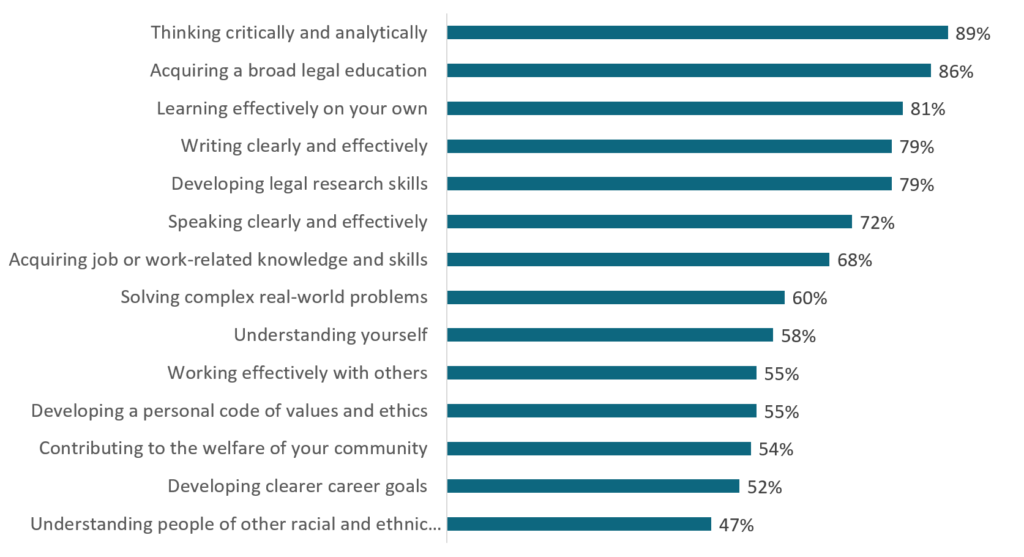
Once the LSSSE respondents enter practice, moreover, they may be less sanguine about their preparation. Many new lawyers in our focus groups told us that their first year of practice was a “trial by fire.” They struggled to counsel clients, develop strategies, and resolve matters with little supervision. Once on the job, they discovered that they needed more job-related skills than law school provided. Why, they asked, didn’t law school better prepare them for the full range of their work?
Legal educators often say that employers are better suited than professors to teach advanced practice skills. Law school, they argue, properly focuses on teaching basic skills (such as case analysis), threshold concepts, and detailed doctrine. But our research partially disputes that claim. New lawyers undoubtedly need the basic skills and threshold concepts that law school instills. But once they possess those competencies, employers are quite capable of teaching junior lawyers specialized doctrine. Indeed, many new lawyers practice in fields that they never studied. In contrast, employers lack both time and expertise to teach advanced skills like counseling clients, gathering relevant facts, and negotiating with adversaries.
Law school is the place to learn these complex skills. Clinicians and other skills professors know how to teach cognitive skills like counseling, fact gathering, and negotiating. They also know how to provide feedback to novices and coach them to competence. Workplaces offer opportunities to hone professional skills, but schools are the best place to learn the basics.
Some lawyers think of counseling, fact gathering, and negotiating as soft skills that can’t be taught. But there’s nothing soft or unteachable about these skills. They’re harder to teach than the skills we teach in the first-year curriculum, but they’re quite teachable. Think of these skills as the second stage of learning to think like a lawyer. First-year students learn how to analyze legal materials, synthesize those materials, and apply legal rules to hypothetical problems. Those skills lay a foundation for learning more complex skills like counseling, fact gathering, and negotiating. The latter skills require students to add multi-dimensional clients, uncertain legal processes, and shifting fact patterns to their two-dimensional analyses.
If we want our graduates to serve clients effectively, law schools must step into the fourth dimension. Before graduation, every student should learn to counsel clients, gather facts, negotiate, and perform the other multi-dimensional skills embodied in the twelve building blocks listed above. The LSSSE survey can help us continue to track progress on that essential front.
The word "impotence" is considered outdated and is rarely used in modern medical sources. It is used when more than 75% of attempts to get an erection during sexual intercourse end in failure. A more https://www.faastpharmacy.com/ accurate and modern term is "erectile dysfunction", which describes a variety of problems in bed in young and mature men.
Guest Post: Legal Education and the Illusion of Inclusion
Guest Post: Legal Education and the Illusion of Inclusion
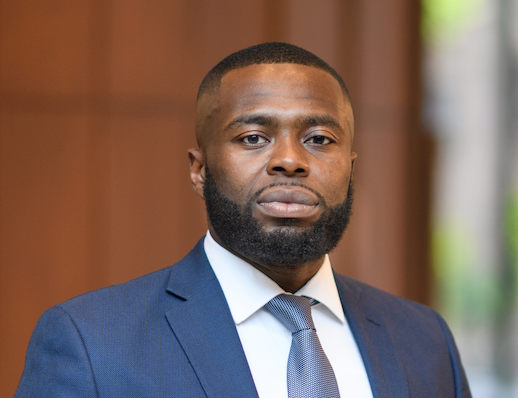 Shaun Ossei-Owusu
Shaun Ossei-Owusu
Presidential Assistant Professor of Law
University of Pennsylvania Carey Law School
A new semester and a potentially new political landscape are upon us. Last month law students around the country resumed coursework. Their educational pursuits are virtual, in-person, or some mix of both. No matter the format, law students continue their educational journey in an ideologically polarized pandemic society where race, class, and gender disparities are on sharp display.
Students will also be learning in a context where changes in our legal system may have direct relevance to their legal education. As is typically the case, a newly constituted Supreme Court has a diverse docket this term that might shape substantive areas of law that students take courses in, chiefly constitutional law. There will be regulatory shifts that come with new administrations. These kinds of changes will have meaning for administrative law and related areas of law: health law, environmental law, employment law, and civil rights, to name a few. COVID-19 has upended state and federal judiciary systems in ways that have still-undetermined implications for procedural courses law students take (e.g., evidence, civil procedure, criminal procedure) and access to justice issues more generally. And we know from the late Deborah Rhode’s work which communities access to justice issues tend to devastate—racial minorities, women, and other marginalized populations.
Notwithstanding future uncertainty, one thing can be said with some measure of confidence: issues of race and gender—amongst other social categories—will remain relevant inside and outside the sometimes intellectually-cordoned off walls of law schools. How these issues are integrated in the classroom, if they are at all, will affect the substantive learning of law and will either include or exclude historically marginalized groups.
In the specific context of legal education, the results of Law School Survey of Student Engagement’s (LSSSE) Annual Survey illuminate. The Report provides a glimpse into how law schools fail to meet the aspirational goal of inclusion that often takes up primetime real estate on their websites and promotional materials. From my own read, the most jaw-dropping finding is intersectional in nature and about Black and Latinx women law students—aspiring attorneys who are often told that they do not look like lawyers when they transition to practice. 26% of Black women respondents and 17% of Latinx women respondents reported that their schools do “very little” to support racial and ethnic diversity.
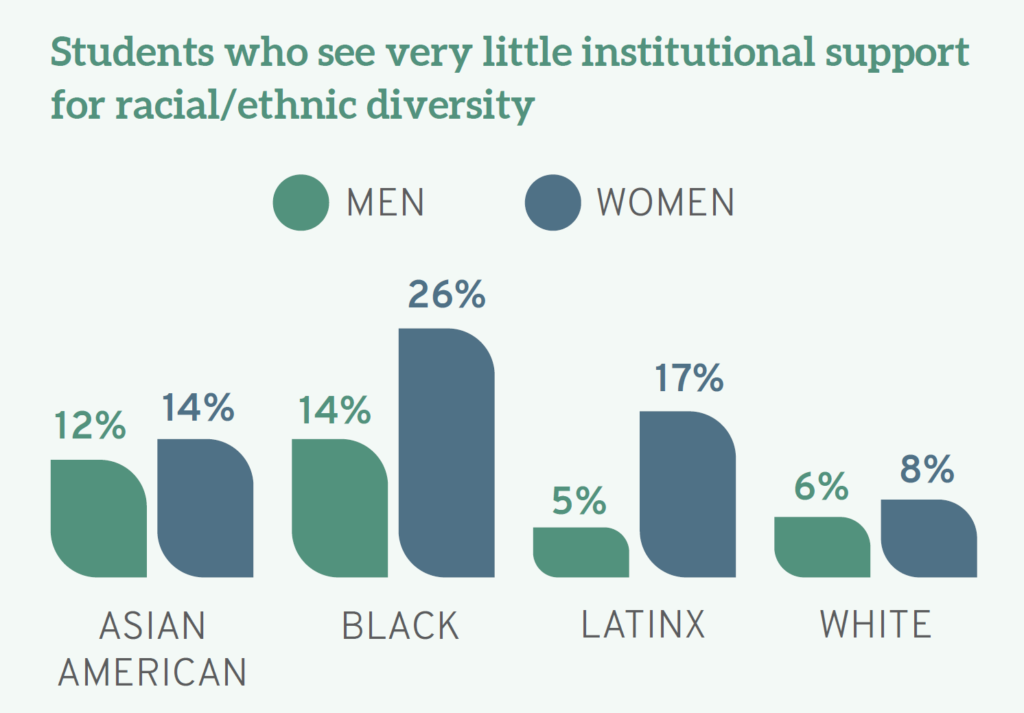
Disenchantment with the lack of support for diversity can be distilled even further. The Report notes that men varied on the issue of gender inclusivity, with 39% “very much” believing that their schools support gender diversity compared to 27% of women and 9% of individuals who identified with the “other gender” category.
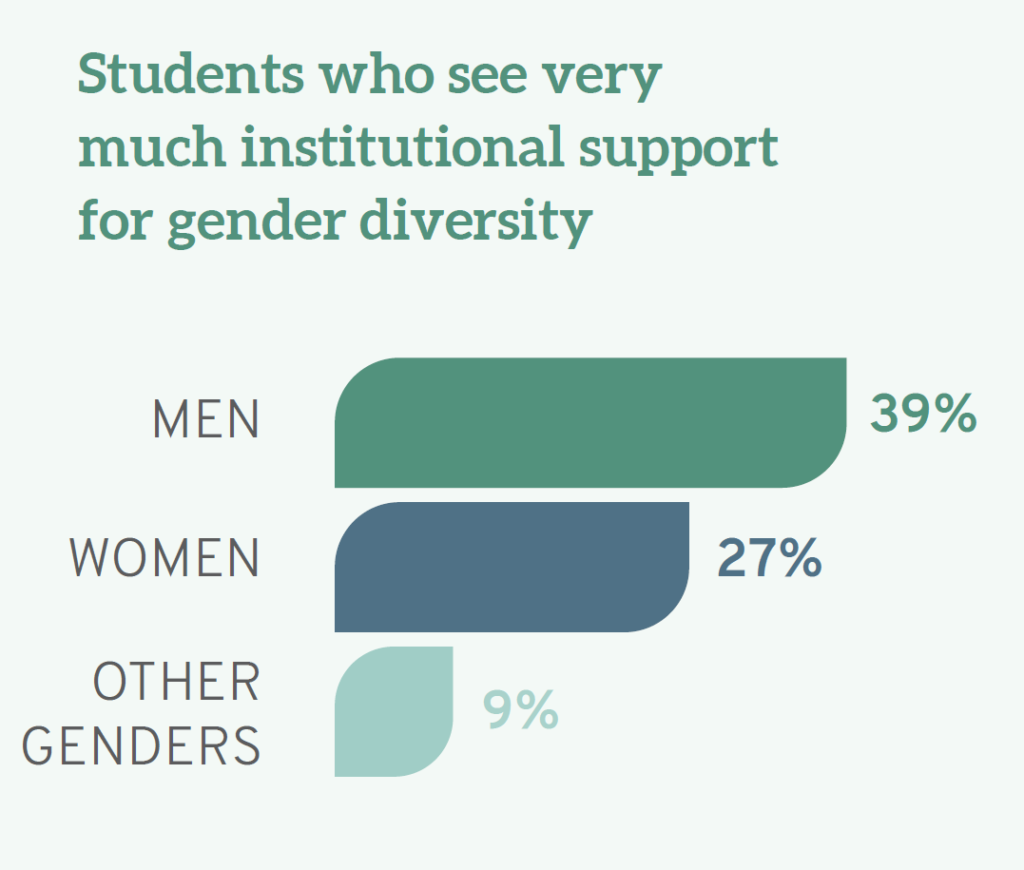
In the context of race, student views also differed, with 9% of White students, 14% of Native American students, 18% of Latinx students, and 25% of Black students believing that their schools do “very little” to ensure that students are not stigmatized based on identity.
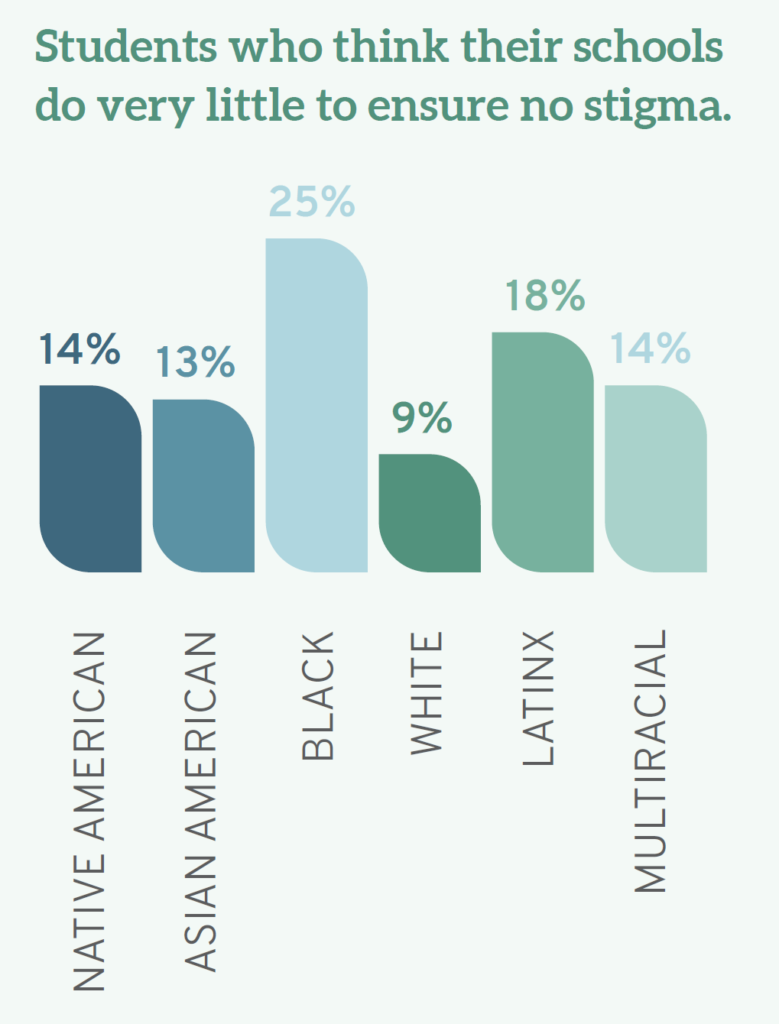
Where sexuality and sexual orientation are concerned, 11% of heterosexual students think their schools do only “very little” to avoid identity-based stigma; conversely, 20% of gay students, 16% of lesbian students, 15% of bisexual students, and 19% of those who identify as another sexual orientation see their schools as doing “very little” in this regard. What do these findings mean for legal education and the political moment I gestured to in the beginning?
LSSSE’s data suggest that some students are dissatisfied with the six-figure education they are receiving. Put plainly, law students from backgrounds that the profession has historically excluded—women, racial minorities, LGBTQ communities, and people with disabilities in particular—do not feel part of the academic community and believe law schools are relatively disinterested in their stigmatization. In some ways, this is unsurprising, as there is a deep scholarly literature and genre of books on student disappointment with law school. Moreover, student disenchantment with legal education—which has a history of exclusion that traces back to the nativism and anti-Semitism of the early twentieth century—may in some ways be pre-determined.
The confines of the classroom, which is one of the many areas the LSSSE survey discusses, provides more insight into the inclusion-exclusion dyad. From the vantage point of some educators, law school is simply about training people to be lawyers. The most generous reading of this position suggests that social justice-like ideas like “inclusion” are too ideologically weighty to meaningfully bring in the classroom. For people who subscribe to this view, attempts at inclusion can create impossible-to-navigate landmines for professors. More skeptically, some see inclusion as an ancillary. Read in this light, the primary goal is to inculcate legal knowledge. For these professors, some things are not relevant to the practice of law and are therefore not relevant to legal education.
Such professional school-based views of legal education, vary in their reasonableness, but are held by swaths of the professoriate. Yet, there is a two-fold problem, and this is where the LSSSE survey is especially useful. First, this vision of legal education rubs up quite abrasively against the representations of law schools as bastions of inclusion. Second, this version of education, in some ways, undermines the well-touted “diversity rationale” in affirmative action jurisprudence. What does diversity mean when the subjects of diversity feel alienated?
Considering the mismatch between some students’ experiences and the stricter professional school model of legal education that some professors are beholden to, there are some options. Educators can simply be more intellectually honest about the reality that law school is a site of professionalization where inclusion principles can be trivialized. Alternatively, law schools can continue to disingenuously hitch the law school wagon to social justice rhetoric while failing to actualize inclusion as a practice. Or, in the most courageous and imaginative versions of themselves, law schools can refashion their curriculum and use developments in the legal world as opportunities to offer more inclusive learning environments.
For law schools committed to the third way, resources abound. Complaints about the need to diversify the content of law school courses have existed for decades. Scholars such as Derrick Bell and Dorothy Brown have authored casebooks that describe how race intersects with different areas of the legal curriculum, whereas feminist legal theorists, poverty researchers, scholars of law and sexuality have penned their own books, supplements, and articles that all give educational guidance on how to bring these issues into core courses, and do so in ways that are doctrinally sound. Still, some professors—many of whom have the most analytically sharp minds on their university campuses—throw their hands up in despair or continue with the same regularly scheduled program. For some of these instructors, these conversations were absent in their legal education, and they were likely not trained to incorporate these issues. Some may think it would be better to leave this work of thematic inclusion to their more expert colleagues (e.g., scholars of race, sex, class, disability) rather than wade into territory where they are sure to mess up. But throwing one's hands up in despair is increasingly a less credible course of action. The pandemic, along with the protests of 2020, have forced some people to rethink how they deliver course content, and more importantly, have made inequality a more prominent theme in our public discourse. The current socio-political moment, and the reality of pandemic pedagogy, call for curricular redesign.
Fortunately, the tools to make the classroom more inclusive are available and they are not limited to the usual courses. To be sure, law professors have written about how first-year courses like criminal law and property are inattentive to inequality in ways that produce the responses found in the LSSSE survey and have offered suggestions on how those same courses could easily be improved. But attempts to diversify and create a more inclusive curriculum are not confined to these foreseeable areas of law but can be found in more unsuspecting places like evidence, corporate law, trust and estates, and intellectual property, to name a few.
Law professors have also identified space in the curriculum for trans-substantive engagement with the kinds of questions and perspectives that demonstrate an awareness of inequality, both in legal education and in law more generally. Indeed, I, along with my colleague Karen Tani, have taken on the task of trying to simultaneously create an inclusive learning environment that rigorously addresses inequality by creating a 50-person Law and Inequality course at Penn Law. This endeavor and more meaningful engagements with diversity need not be limited to women, racial minorities, and sexual minorities. Inclusion also implicates and has meaning for the larger law student population. One of the most understated findings in the LSSSE Report is that 16 percent of white students believed law schools placed “very little” emphasis on issues of equity and privilege and do not prioritize providing students with the skills necessary to confront discrimination and harassment.
My purpose here is not to proselytize teaching a course like the one we are offering. Instead, I want to highlight how student dissatisfaction with inclusion, which the Report highlights in detailed and accessible fashion, can be situated within this critical juncture. 2021 is a unique moment where law schools can reimagine legal education in real time, and for a post-pandemic world. This will not be easy, as this is a stressful time for faculty—some of whom are in high-risk groups during the pandemic and/or have a variety of care obligations. COVID-19 has upended a lot of assumptions and forced people to change longstanding pedagogical practices. Institutions could do a lot of good by encouraging faculty reflection and supporting creative reorganization of current courses.
The LSSSE Report tells us that in many ways, law schools are failing to provide the inclusive educational spaces that they, I believe in good faith, want to offer and that students of various backgrounds actively desire. Ultimately, the teaching tools are available, the moment is ripe, and the only outstanding question is whether legal educators will make the changes necessary so that the next LSSSE survey offers more optimistic findings.
Guest Post: Connections and Community in Distanced Classrooms
Guest Post: Connections and Community in Distanced Classrooms
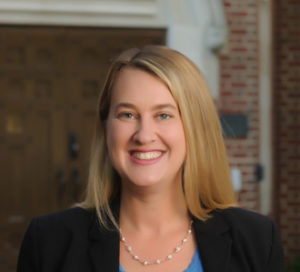 Jessica Erickson
Jessica Erickson
Professor & Associate Dean for Faculty Development
University of Richmond School of Law
Law faculty put significant thought into designing courses. We draft learning objectives, carefully craft assessments, and consider how to engage students inside and outside of the classroom. When law school courses suddenly moved online, many faculty had to think about a new aspect of course design how to build connections in classrooms where students were remote. Even in classes that were able to meet in-person, many of us found it difficult to develop a classroom community when students were in masks and seated six feet apart.
When we could no longer have casual conversations with students after class or in the hallways, many of us realized just how crucial these connections are for our students and for us. In this blog post, I discuss the importance of relationships to student learning and outcomes, as well as how to develop these relationships in online, hybrid, or physically distanced classes.
- The Importance of Relationships
Connections and community are essential to student learning. As I have previously discussed, research from undergraduate institutions shows that a sense of community is associated with increased motivation, greater enjoyment of classes, and more effective learning. Crucially, data from the Law Student Survey of Student Engagement (LSSSE) shows that these connections matter to law students as well. LSSSE data has been used to examine both the inputs and outputs of law students’ sense of belonging. Using LSSSE data, we can gain insight into what causes law students to feel a sense of belonging (inputs) and the impact that a sense of belonging has on law students’ performance in law school and their career (outputs).
Starting with inputs, LSSSE’s 2018 report Relationships Matter surveyed more than 18,000 students at 72 law schools. The report concludes: “Relationships with faculty, administrators, and peers are among the most influential aspects of the law student experience. These connections deepen students’ sense of belonging and enhance their understanding of class work and the profession.” Connections, in other words, are key when it comes to fostering law students’ sense of belonging. Law schools are doing a good job at developing connections, with 83% of students stating that they have at least one faculty member whom they could approach for advice or guidance.
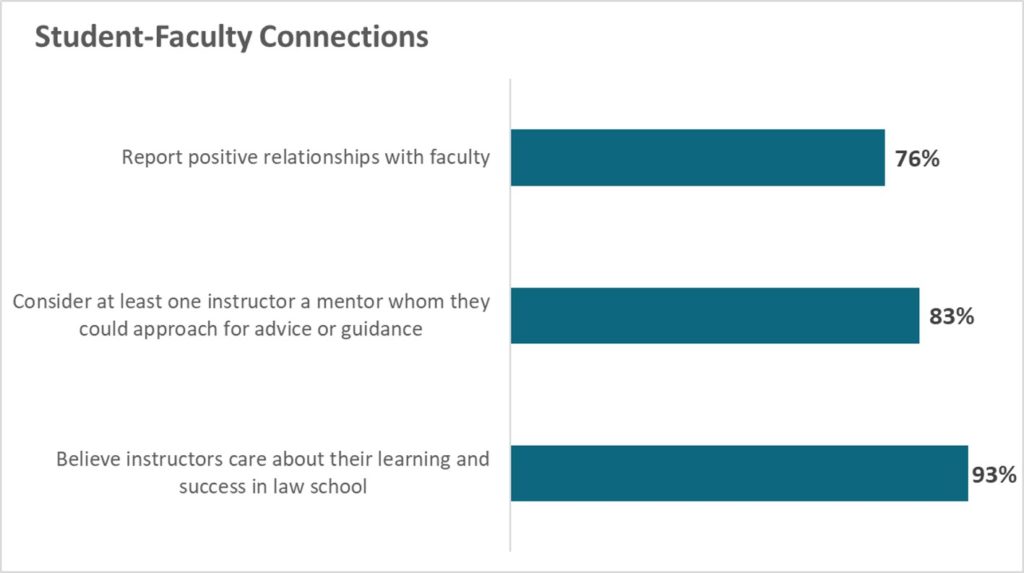
When it comes to outputs, we can look at research by Professor Victor D. Quintanilla using LSSSE data. He found that a sense of belonging significantly predicted three key outputs – (1) students’ overall experience in law school, (2) whether they would choose to go to law school again, and (3) their academic success (i.e., law school GPA). Moreover, not only does a student’s sense of belonging predict academic performance, but the impact was even greater than other commonly used predictors such as undergraduate GPA and LSAT scores. This means that, even if students come to law school with different academic backgrounds, we can help close this gap by fostering our students’ sense of belonging.
Unfortunately, the research also suggests that building this sense of community is much harder in online or hybrid courses, which most of us who taught this past fall can probably confirm. Now we need to think even more deliberately about how to develop these connections in our classes.
- Building Relationships in Remote or Physically Distanced Classrooms
This past summer, I wrote two blog posts, one with suggestions on how faculty can connect with students in these new learning environments and the other with suggestions on how faculty can help students connect with each other. In this post, I want to reflect back on these strategies now that I have tried many of them with my own students.
First, I found office hours to be a key way to connect with students. I renamed my office hours “student hours” on the advice of a colleague, and I borrowed language from this same colleague to include in my syllabus: “I call these ‘student hours’ for a reason: they are for you. You should come to these student hours if you have a question about the course, but you can also just stop by to introduce yourself, ask any other questions, or talk about your law school experience. I want to get to know you!” At the start of each meeting, I talked with students about how law school was going, and it was a great opportunity to get to know them better.
I call these ‘student hours’ for a reason: they are for you. You should come to these student hours if you have a question about the course, but you can also just stop by to introduce yourself, ask any other questions, or talk about your law school experience. I want to get to know you!
Second, I used technology to connect with students individually. I asked each of my students to create their own Google Doc and share it with me, and they were required to compete short pre-class assignments in their Google Docs. I’ve used this strategy in the past, and found it to be a great way to make sure that students understand the reading. This semester, though, I set aside 1-2 hours before each class to include personal comments on each students’ assignments. I had 52 students across two classes, so it took a while, but it allowed us to connect more personally. I also gave them “Just for Fun” optional questions to include in their Google Doc where they could tell me their favorite board game or share a picture of their pet. I featured a few at the start of class, which was a fun way to personalize a class full of masked students. You can read more about my pre-class assignments here.
Third, several of my colleagues set up individual and small-group meetings with students. One colleague held individual “office hours” with each student. Another who taught a hybrid class met separately with all of her students who were fully remote. A third held online coffee breaks with 3-4 students at a time where the only rule was that they could not talk about course material.
Fourth, optional events allowed me to connect with students in a more relaxed way. In class, I was often preoccupied with the day’s material and all of the tech challenges of my hybrid classroom. In optional events, however, we could talk and connect in a lower-stakes way. I held an optional discussion about a Supreme Court oral argument. I also held review sessions and a Civil Procedure game night where students competed in an online kahoot! If you’ve never tried a kahoot!, I strongly recommend it. It was a great way to let students test their knowledge and have fun at the same time.
Finally, I created opportunities for students to connect with each other. Many faculty were not sure whether students could work in groups six feet apart and wearing masks. It turns out that students can work together pretty easily even under these circumstances. Although it was tempting to incorporate more individualized assessments to keep students separated, it’s important to give them opportunities to deepen their learning with each other. I sometimes felt like a middle school dance chaperone reminding students to stay an appropriate distance apart, but it was worth it.
The final thing I will add is that we need to be careful that our efforts to connect with students do not overwhelm them or us. It is tempting for these community-building exercises to be added on top of what we already ask our students to do in our courses. Now that we have some experience in these new classroom settings, we can be a bit more selective in what we choose to include and assess whether we need to scale back in other areas. At the end of the day, though, as LSSSE data has shown us, relationships matter, and we need to think about how to cultivate these relationships even in these unusual times.
Guest Post: Issue (Blind)Spotting: Using Data to Understand Candidate Motivations to Attend Law School
Guest Post: Issue (Blind)Spotting: Using Data to Understand Candidate Motivations to Attend Law School
 Kristin Theis-Alvarez
Kristin Theis-Alvarez
Dean of Admissions and Financial Aid
Berkeley Law
Law school trains students to “issue-spot.” This means faculty test whether students can apply general knowledge to novel situations. The approach mimics the day-to-day practice of law: a client walks through the front door and you weave together their particular issue with your understanding of the applicable law in general. This isn’t unlike what admissions office representatives do when presenting to or advising prospective applicants. I’ve been in law school admissions since 2007, and have communicated with countless candidates, read thousands of applications, and partnered with a wide range of organizations that seek to increase access to legal education – so I have some sense of what applicants are asking. Against that backdrop (what admissions professionals believe is generally true about people interested in law school), our role is to offer advice based on specific candidate concerns. Where do we gain that broader understanding? LSSSE survey data is a good place to start if we want to move beyond anecdotal evidence. It can inform our understanding of candidate motivations for pursuing a law degree which then refines our outreach and recruitment messaging.
For example, through LSSSE data we learn that most students cite a desire to have a challenging and rewarding career as the most influential factor in their decision to enter law school. Over three-quarters of respondents indicated this was their primary motivation for seeking a law degree. So, it’s reasonable to suppose that when speaking to a room of prospective applicants, admissions professionals ought to emphasize career opportunities and employment outcomes. We might focus that message to highlight our school’s unique attributes (placing more emphasis on the percentage of our graduates working in public interest law or the number with federal clerkships, for example), but we’re always speaking to that core motivation.
Another significant motivator for law school attendance is the extent to which earning a law degree can lead not just to a rewarding career, but a lucrative one. LSSSE data tell us that many law students are pursuing the degree based on a desire to work toward greater financial stability. Taken together, the ability to get a job – and for that job to be one that provides financial stability – largely informs the decision to attend law school. This leads admissions professionals to frequently reference our school’s median starting salaries, and partially explains why we emphasize a ‘return on investment’ model to justify the cost of the degree.
LSSSE data also suggest that a desire to further one’s own personal academic development is a significant motivator for law school attendance. As a result, admissions professionals might emphasize our school’s leading programs, commitment to experiential education, research centers, and interdisciplinary education opportunities. We explain that law school is one of the few graduate programs where the strong possibility of professional and financial success intersects with that of individual growth. (More people might pursue a PhD in Classics if the academic job market looked different, and we might have fewer law students if instead of teaching through the casebook method we just handed everyone a list of rules to memorize.) We balance employment statistics with anecdotes about student skills being developed and deployed.
At the same time, less than half of LSSSE respondents report that an “inherent interest” in the curriculum or material they are learning is a source of motivation for them to work hard in law school. This may be why most law admissions professionals are not talking to eager undergraduate students about provisional remedies. It’s also why we generally explain a legal education as the opportunity to develop a diverse toolkit that can be used to solve complex problems, and not merely a content delivery method. Instead, more than half of respondents cite being competitive in the job market as a primary motivation to work hard in law school.
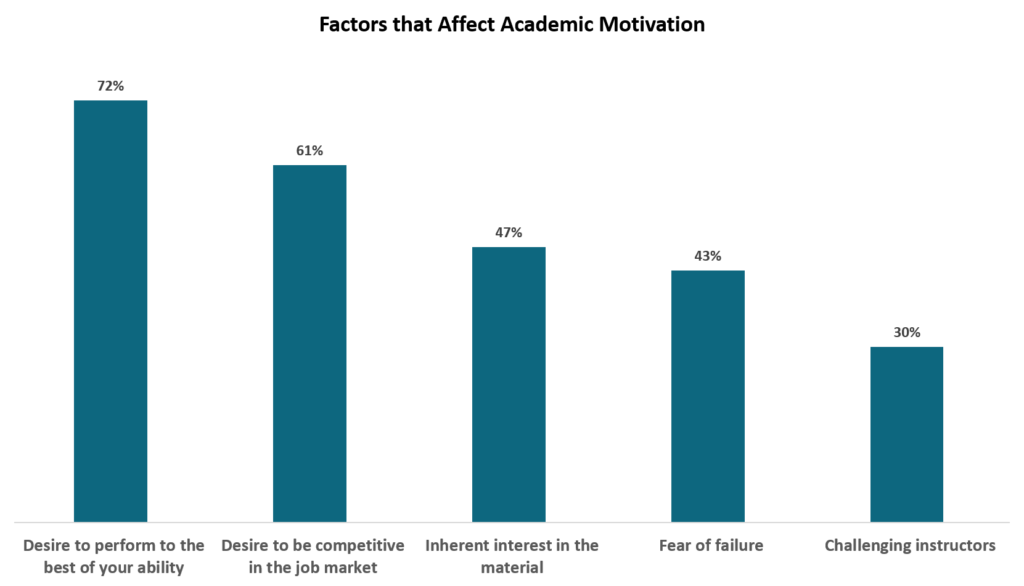
However, there are assumptions that admissions professionals might make when deploying student experience data in our work. Are we asking who we mean when we say “law students,” and who we imagine when we picture “prospective applicants”? More importantly, how do those assumptions lead to missed opportunities to reach candidates from backgrounds underrepresented in the applicant pool?
One way to illustrate this is to examine the differences between general LSSSE data about motivations for attending law school and what we know about the motivations for particular groups. Within the National Native American Bar Association (NNABA) Report “The Pursuit of Inclusion: An In-Depth Exploration of the Experiences and Perspectives of Native American Attorneys in the Legal Profession,” there is a section on the pipeline to law school and the legal profession with a forward written by Stacy Leeds, Dean Emeritus and Professor of Law at the University of Arkansas. This section of the NNABA Report indicates that Native American attorneys were more motivated to enter law school in order to give back to their tribe or Nation, to fight for justice for Indians, and to fight for the betterment of Native peoples’ lives, and less motivated by personal or financial benefit. The data suggest that Native American attorneys’ motivation for attending law school is more connected to identity and heritage, and less tied to individual benefit. According to the NNABA Report, “The difference in why many Native Americans may go to law school is fundamental to understanding how to inspire and motivate more Native Americans to consider law school and the legal profession.” Therefore, not talking to Native American candidates about how to leverage a legal education to serve Native peoples is a missed opportunity to build or fortify interest in the degree.
LSSSE survey data can and should inform a law school admissions office’s outreach and recruitment efforts, but aggregate data can’t be the end of the inquiry. Even within LSSSE data lies the opportunity to further disaggregate, dig deeper, and challenge our assumptions. Admissions professional making use of quantitative data must intentionally work to avoid participation in, or replication of, what Professor Victoria Sutton termed the “paper genocide” of Native American students. And as the NNABA data demonstrates, it’s not safe to assume that what’s true for most is true, or even relevant, for all. Furthermore, the 2020 LSSSE Annual Report “Diversity & Exclusion” shows that the contours of these distinctions persist during (and may even be amplified by) the law school experience itself. Law admissions professionals should therefore question our assumptions about the audiences we speak to, and the students we speak about. Like good lawyers, we must hold general information in the back of our minds, but also listen carefully, research meticulously, and make adjustments. Spotting that issue will not only make admissions professionals more effective, it will ultimately contribute to a more diverse legal profession.
Guest Post: Beyond Enrollment: Why Motivations Matter to the Study of Legal Education and the Legal Profession?

Stephen Daniels
Senior Research Professor
American Bar Foundation
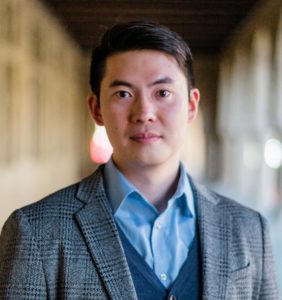
Shih-Chun Chien
Research Social Scientist
American Bar Foundation
The upheaval caused by COVID-19 pandemic might change everything we know about legal education. Reports in the legal media have speculated on the impact of COVID-19 on law school applications, enrollments, budgets and, ultimately, even survival. Depending on the timing, that speculation can run from the negative to the somewhat hopefully positive.[1] Some of the uncertainty comes from the disruption in the normal application to enrollment process – like the cancellation of in-person LSAT testing. More broadly, it surely comes from the truly unprecedented situation in which we find ourselves.
The uncertainty provides an opportunity – in fact, it may require us – to think critically about the homogenized aggregate numbers of applicants and matriculants we often see along with the broad environmental factors said to drive them. With just a few notable exceptions, most recently the 2017 AALS/Gallup surveys,[2] one is tempted to agree with the statement made almost a lifetime ago, “Vague notions, old myths, and thought-shrugging generalities are all we have to describe the raw material from which our lawyers come.”[3]
We need to think systematically about the variety of individual motivations or reasons that may help us understand those prized numbers. This means going beyond the following common idea that appeared recently:
[W]e could also be looking forward to another onslaught of law school applicants thanks to the economic downturn that’s been caused by the pandemic, just like what happened with the recession. ‘In the short-term, going to professional school – be it business school, law school or something else – is a good idea because it’s a refuge from an inhospitable job market, and the job market will be better three years from now.’[4]
An “escapist” explanation like this one is an old one,[5] but its vintage does nothing for its veracity or usefulness.
Such explanations strip any real substance out of the idea of motivation, telling us little about the decision to attend law school and nothing meaningful about the choice of law as a career – and ultimately, this is the important issue. The same is true for explanations that look for environmental causes not escapist in character. A recent variant not tied to escapism is the so-called “Trump Bump.” Here it is the idea that opposition to President Trump – and the overall results of the 2016 election – drove more people to law school than would have been expected. In fact, there may not have been much to it. The bump may have been as much a matter of marginal increases and wishful thinking as anything meaningful. It too is a motivation without real substance if we’re talking about the choice of a life-time career as a professional.[6]
What should we make of a profession that, apparently, is made up of people choosing it for short-term reasons of escape or narrow, time-specific political reasons? Or maybe law school is something akin to Marine Corps training that fundamentally changes the varied lives of the recruits into a singular entity with a distinct mission.
Understanding the motivations that underlie aggregate figures is important for two central reasons in addition to any others. The most immediate and most obvious is enrollment. Law schools must have enough students and the accompanying tuition dollars to keep the doors open. All else of importance depends on this and at some points in time the need for students is more urgent. An article reporting on some of the 2017 Gallup/AALS findings opened by noting the sharp decline in after 2010 in the numbers of people interested in law school and saying that “legal education leaders were posing questions that simply could not be answered definitively: Why is this happening? When will it end? Can we do anything to stop it? … What motivates undergraduates to attend law school or deters them from attending?”[7] Important as these questions are, they are just a beginning.
The more far-reaching reason goes to the role of law schools as the gatekeepers to the profession.[8] They are key in shaping what the profession will look like, what it will be, and even what it will do. Law schools do so through the curriculum, pedagogy and the socialization process – and they do it with the people who choose to attend. Paying attention to general factors in the environment without a good sense of the varying motivations involved in the decision to attend law school is insufficient for performing that role well. That is, unless one is prepared to think those variations – the why, the who, and the interaction of the two – are irrelevant. That the substance of the raw material – beyond LSAT scores and GPAs – is irrelevant so long as the supply chain keeps moving. Literatures in psychology and on organizations suggest that motivations can be important for understanding the outcomes of legal education, especially graduates’ career aspirations. That substance is not irrelevant if we care about the nature of the legal profession and the role it plays or should play in our society.
 In short, motivation should not be simplified to provide just so explanations for law school application or enrollment trends. It is time to look more closely at the variations in and the complexities and dynamic components of motivation. This includes topics like shifts in motivations in response to changing environmental conditions or the possible links between particular variants of motivation and career aspirations or how such inclinations may be changed by the law school experience.
In short, motivation should not be simplified to provide just so explanations for law school application or enrollment trends. It is time to look more closely at the variations in and the complexities and dynamic components of motivation. This includes topics like shifts in motivations in response to changing environmental conditions or the possible links between particular variants of motivation and career aspirations or how such inclinations may be changed by the law school experience.
Some students may just want to join and prosper in the hierarchical legal profession, but others may want to use their legal training and position to change the world. But perhaps more importantly, many may think they want the latter but end up pursuing the former. Do motivations vary depending on one’s characteristics or background? In the deeper past this question may have been easier to address since law students were almost all white and male and from relatively affluent backgrounds, but no so today with a much more diverse student body. What difference, if any, do such changes make?
The earliest motivation studies go back to the 1960s and 1970s,[9] when the legal education landscape looked very different than today. There were fewer law schools but depending on the year chosen for comparison not necessarily fewer students than today and a decidedly non-diverse student body. This means many of their findings may not be all that relevant now, but some are (and that’s a topic for another post).
Perhaps most importantly, the early motivation studies set the stage for later ones even if they did not literally use the same survey questions. All studies, from two 1961 NORC surveys to the 2017 AALS/Gallup surveys,[10] share an interest in a small but varied set of themes surrounding: making money; prestige and professional advancement; serving the public good; the influence of others, especially family; the intellectual side of the profession; independence; and a catch-all category for those with no substantive motivation like waiting out the poor job prospects in sluggish economy. All find that individuals have a mixture of motivations – some more intrinsic, others more extrinsic – with different degrees of importance or intensity.[11] There are some basic consistencies – money and prestige are always important; yet, so are motivations that speak to the public good and to the kind of career wanted. The picture is a nuanced one.
The extant studies, old and more recent, share something else. In addition to asking about motivation they also asked students a host of demographic questions about the students themselves and their family backgrounds. They remind us that the pool of people considering a career in law has changed over time and suggest that motivations may vary among the different groups making up that pool and change over time.
One source – a data set rather than a published analysis – went farther in asking law students numerous questions about their legal education and the type of law they would like to practice along with the setting in which they would like to work. It allows us to look for connections among motivations, backgrounds, law school engagement, and most importantly what a student hopes to do. Motivations become intelligible and meaningful to the extent they are connected to what students – with different backgrounds – hope to do and how well their law schools meet their expectations.
That source is a group of questions included in the 2010 LSSSE survey of law school students. In addition to the broad set of questions asked in the annual LSSSE surveys the 2010 survey asked students at 22 law schools to rate the level of influence of seven possible reasons for choosing to attend law school (reasons readily recognizably in light of earlier studies). From those schools 4,626 responded. Among other things, the survey found that among first year students, the most influential factor in the decision to enter law school was the desire to have a challenging and rewarding career (figure 1). The survey also found a relationship between student motivation and academic engagement.
Figure 1: Percentage of 1Ls who rate each factor "highly influential" in their decision to attend law school (rated 6 or 7 on a seven-point scale)
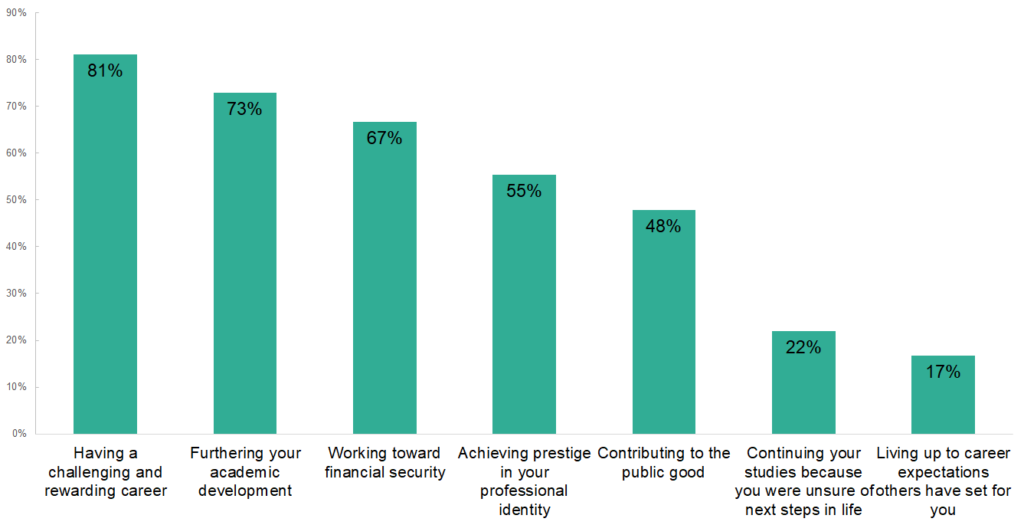
The 2010 LSSSE is important for another reason. It provides a fascinating snapshot at a critical moment in the contemporary history of legal education: the peak of greatest enrollment, immediately after which came the “great enrollment decline.” The 3Ls in the survey would have made their choice before the Great Recession hit and the 1Ls would have made their choice at a time when the recession was well underway. How might motivations and other student characteristics have differed between these two cohorts – one choosing in better times and the other in worse times?
By 2015 the decline ended and enrollments leveled-off – but at numbers not seen since the 1970s. Students starting this fall will have made their choice as the COVID-19 pandemic – along with its collateral damage – was unfolding, and 2020-21 3Ls would have made their choice in 2018, amidst a robust economy. Are the motivations different? Are the students different?
More interestingly, what would we find if we asked the exact same questions in the spring 2021 LSSSE survey as asked in the spring 2010 LSSSE survey?[12] Are motivations different in this changed world compared to those found in the 2010 data? Are the students different?
While we are working now with the 2010 data to address some of the questions above, we are also working with the LSSSE administrators to include those questions in the upcoming 2021 LSSSE survey. This will allow us to address not only differences at two points in time but changes in motivations, students, and students’ views of their legal educations. Doing so will help provide a fuller understanding of what may underlie students’ reasons to choose law as a career and how well law schools meet those motivations.
__
[1] Staci Zaretsky, “Should Law Schools Be Expecting Another Onslaught of Applicants Thanks to the Pandemic?” Above the Law, April 24, 2020, https://abovethelaw.com/2020/04/should-law-schools-be-expecting-another-onslaught-of-applicants-thanks-to-the-pandemic/; Karen Sloan, “Law School Applications are Down: Will COVID 19 Spur a Late Comeback?” Above the Law, June 3, 2020, https://www.law.com/2020/06/03/law-school-applications-are-down-will-covid-19-spur-a-late-comeback/ : Karen Sloan, “Law Schools See Late Application Boost After Spring COVID 19 Slowdown,” July 14, 2020, https://www.law.com/2020/07/14/law-schools-see-late-applicant-boost-after-spring-covid-19-slowdown/.
[2] See Association of American Law Schools and Gallup, Before the JD: Undergraduate Views on Law School (2018); American Association of Law Schools, LSAC and Gallup, Beyond the Bachelor’s: Undergraduate Perspectives on Graduate and Professional Degrees (2018); Jeff Allum and Katie Kempner, “Inside the Minds of Future Law School Grads: Some Findings from Before the JD,” 87 The Bar Examiner (Winter 2018-1019), https://thebarexaminer.org/article/winter-2018-2019/inside-the-minds-of-future-law-school-grads-some-findings-from-before-the-jd/.
[3] Louis Toepfer, “Introduction,” in Seymour Warkov and Joseph Zelan, Lawyers in the Making (1965); at xv.
[4] Zaretsky, supra note 1, quoting Bernie Burke; see also Sarah Zaretsky, “Law School Applications on the Rise Thanks to Bad Job Market: Law Schools Will Happily Take Applicants’ COVID cash,” Above the Law, July 14, 2020, https://abovethelaw.com/2020/07/law-school-applications-on-the-rise-thanks-to-bad-job-market/.
[5] On escapism, see Barry Boyer and Roger Cramton, “American Legal Education: An Agenda for Research and Reform,” 59 Cornell Law Review 221, 253 (1974); Robert Stevens, “Law Schools and Law Student,” 59 Virginia Law Review 551, 616 (1973).
[6] Stephanie Francis Ward, “The ‘Trump Bump’ for Law School Applicants is Real and Significant, Study Says,” ABA Journal, February 22, 2018, https://www.abajournal.com/news/article/the_trump_bump_for_law_school_applicants_is_real_and_significant_survey_say; Karen Sloan, “Forget the ‘Trump Bump:’ First-Year Law School Enrollment Dipped in 2019,” December 12, 2019, Law.Com, https://www.law.com/2019/12/12/forget-the-trump-bump-law-school-enrollment-dipped-a-bit-in-2019/.
[7] Allum and Kempner, supra note 2.
[8] See Boyer and Cramton, supra note 5, at 224.
[9] See Warkov and Zelan, supra note 3; Leonard Baird, et al., The Graduates: A Report on the Characteristics and Plans of College Seniors (1973); Stevens, supra note 5.
[10] See Warkov and Zelan, id; AALS/Gallup, Before the JD, supra note 2.
[11] Intrinsic motivation refers to the desire to expend effort based on interest in and enjoyment of the task or effort itself – like a motivation driven by the intellectual side of things. In contrast, extrinsic motivation refers to the desire to conduct certain activities to obtain outcomes external to the task or effort itself, such as rewards or recognition – like money or prestige.
[12] See Benjamin Page and Robert Shapiro, The Rational Public: Fifty Years of Trends in Americans’ Policy Preferences (1992), 39: “question wording matters … The only safe way to identify opinion change, then, is compare answers to identical survey questions.” (emphasis in the original)
Guest Post: Some Tips for Improving Student-Faculty Relationships in Law School
Guest Post: Some Tips for Improving Student-Faculty Relationships in Law School

Susan Wawrose
Professor Emerita
University of Dayton School of Law
Law student distress remains an ongoing challenge for law schools. Always an important concern, student well-being deserves even greater attention now during this time of pandemic. Many law faculty saw this up close last March when they transitioned their classes on-line in response to the COVID-19 outbreak. Through the relentless lens of Zoom, it was hard not to notice that some students were struggling to cope. This may have been because of the abrupt change in environment or a loss of support systems as students were forced to leave campus, or it may have been simply a result of the general uncertainty that affected us all.
In any case, with the virus still rampant, as students return to classes this fall they are entering a brand new landscape. Many can expect some combination of socially distanced in-person learning and on-line classes and all will be asked to adopt new models and protocols for interacting with peers, faculty, and administration. Communication and connection with faculty members will be essential to students as they navigate this new reality. Strong faculty-student relationships have always been important in law school since healthy, appropriate relationships, including those with faculty mentors, both reduce distress and foster student achievement. Now, as the pandemic creates pervasive uncertainty, with its accompanying strains, positive faculty-student interactions can be supportive for all students and especially helpful for those who are feeling untethered, disconnected, or unsure.
Data from the Law School Survey of Student Engagement (“LSSSE”) indicate there is room for improvement in the quality of law student-faculty relationships. A comparison of LSSSE data from 2015-2019 shows that just over 50% of students ranked the quality of their relationships with faculty as especially positive. Students rate the quality of their relationships with faculty from 1 to 7 on a 7-point scale, where a higher rating is more positive, i.e., seven is “available, helpful, sympathetic” whereas 1 is “unavailable, unhelpful, unsympathetic.” Ratings of 6 and 7 are combined to create the “Top 2,” an aggregate of the most positive responses. From 2015-2018, the percentage of students reporting the quality of their relationships fell within the Top Two ranged only from 52% to 58%.
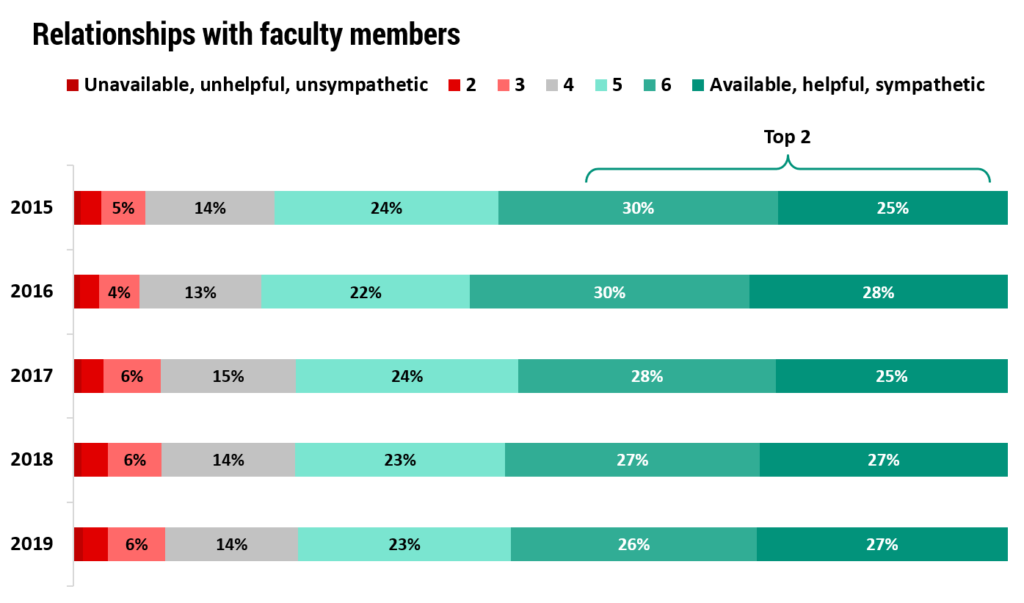
How law students have viewed their relationships with faculty members
With this in mind and with a new semester starting, there are some simple steps faculty can take to improve their relationships with students (both in-person and online) and to begin to develop strong, supportive connections. A full article on this topic is available here: https://papers.ssrn.com/sol3/papers.cfm?abstract_id=3088008
1. Take the time to develop rapport
Building rapport is a relatively simple way to connect with students that faculty can practice nearly every day. The value of building rapport is that it promotes trust and conveys acceptance, thus increasing the likelihood that a student will feel supported and connected.
The process of building rapport includes listening closely, being approachable, and encouraging open communication, so that students will feel able to speak freely and welcome to reach out again. Simple aspects of non-verbal communication such as making eye contact, smiling, and gesturing appropriately and naturally, can all be used to set a positive tone and to signal engagement and interest. It can be helpful to take a breath to center yourself when you begin talking with a student and to remind yourself to look up from your laptop, put down whatever you are working on, and attend to the person in front of you. In addition, building rapport includes appreciating individuality and difference in students, even if their appearance, communication strategies, or other personal qualities do not mesh with your expectations of how a law student should act or appear. Letting go of judgment is not always easy for lawyers, but this act of compassion in personal interactions can support students by creating a more open platform for communication.
2. Practice active listening
Engaged and active listening promotes connection because it communicates respect and caring. Just as with building rapport, it can take a shift of mindset to slow down and set the intention to listen deeply and respond with intention when students speak. But, this shift is valuable because active listening allows students to feel heard and understood.
Active listening involves listening with full attention to both the spoken content as well as the “hidden” messages behind statements. Attention to both verbal and nonverbal messages is important. Verbal and nonverbal communication can also be used to convey that the speaker is being both heard and understood. Non-verbal communication on the part of the listener can include making appropriate eye contact (versus checking your phone or rifling through papers on your desk) or using simple assurances like nodding or use of short words or phrases like “Uh-huh,” “Yes,” and “I see” to confirm understanding and encourage the speaker to continue. Moreover, allowing for some silence while listening can give the speaker time to process and reflect when communication does not flow easily.
Listening well to students is particularly important because, in addition to helping to build relationships, it provides faculty the opportunity to observe and notice when a student seems unusually troubled or unsettled. Thus, faculty who engage meaningfully with students may be the first observers of distress and may find themselves able to provide needed support or direct students to campus support networks.
3. Engage students with empathy
Empathy is an important lawyering skill often taught in clinical and dispute resolution courses. When students discuss their struggles, faculty can opt for an empathetic response to convey a sense of caring and interest in the student experience. Engaging students with empathy builds trust and understanding and supports students by communicating that their ideas and thoughts matter. Students feel heard, rapport is strengthened, and communicating may become easier. A faculty member’s empathetic response to student concerns can promote feelings of well-being and connection. In addition, and importantly, when faculty are empathetic in their communication with students, they model a way of being in a professional setting that students can draw on later in their careers as they seek to develop relationships with both clients and colleagues. That is, through observation, students learn an important professional skill.
By practicing these simple relational skills faculty provide additional support for students and may possibly reduce some of the unproductive and damaging distress students feel. Nudging the percentage of students who report extremely positive relationships with faculty even just a few percentage points higher would be a benefit for all.
Guest Post: Native American Exclusion as a Form of Paper Genocide
Guest Post: Native American Exclusion as a Form of Paper Genocide

Victoria Sutton
Member of the Lumbee Tribe
Texas Tech University School of Law
Recently, I applied for an NSF grant to survey the attitudes and perceptions of Native American scientists about human gene editing. The grant was rejected and one of the comments from a reviewer was essentially, “Why not include other ethnic and racial groups? Why just Native Americans?” I assumed I had done a poor job of explaining why this group would have culturally unique perspectives, and resubmitted. Needless to say, it was not funded.
The profound conclusion this reviewer must have made was that Native Americans have no different perspective from any other ethnic or racial minority group so why make any distinction since there is no value in asking “just” Native Americans their opinions.
The disappearance of Native Americans from statistical data for universities and law schools is not just a quirk of statistics. The word disappearance is intentional, and relates to the genocidal policies of first Great Britain and then the United States against the indigenous population in America. Not only was physical genocide embraced, but paper genocide as well, eliminating references to Native Americans in property records, census records, birth and death records in a paper genocidal policy.
There is no question about genocidal policies and the U.S. as a nation has denounced it and apologized for it, most recently President Obama. Paper genocide has been more subtle but generationally harmful. What amounts to a continuing theme of paper genocide, professional organizations, college data collectors and other observers leave Native Americans out of statistical data collection and reporting. Last year, I was able to find that the LSSSE study of law students included Native American students just as they considered other ethnic and racial groups, and I was able to access useful data for my own research.
From that data some important differences among racial and ethnic law students emerged from the question about how much time per week students spend caring for dependents. Native American law students spend considerably more time per week than other groups on dependent care. The data show that 36% of Native American law students spend more than 16 hours a week on dependent care (which includes taking care of children, parents, or grandparents) compared to 13% of Asian Americans, 18% of Black students, 14% of Latinx students, 20% of Native Hawaiians/Pacific Islanders, 11% of whites and 14% of multiracial students. This may explain why the data also show that Native Americans are more likely than others to say their schools contribute only “very little” to their non-academic responsibilities.
Figure 1. Time spent caring for dependents: More than 15 hours a week 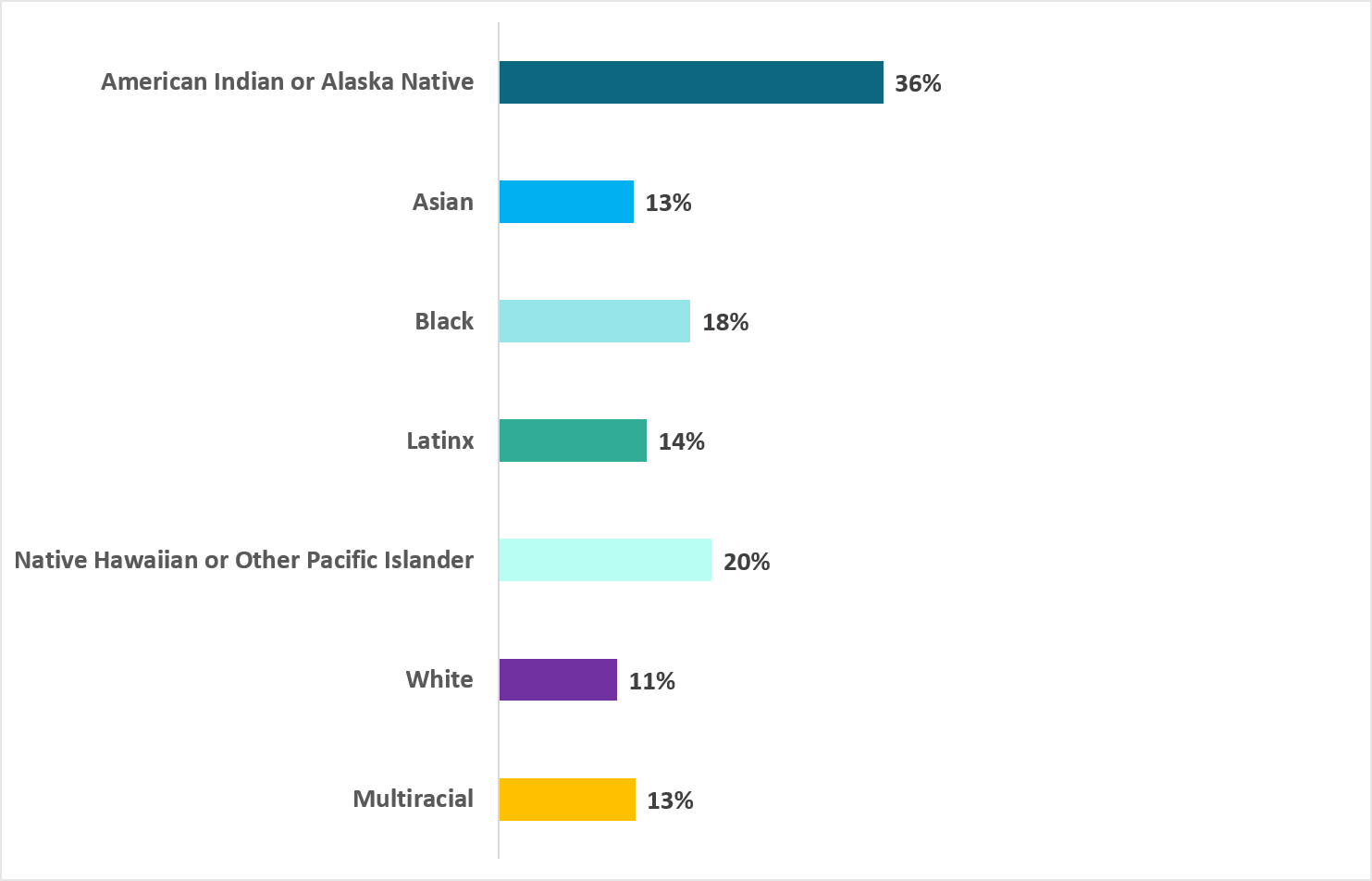
Because LSSSE has longitudinal data, it is clear that the high percentage of Native Americans who spend significant time on dependent care is consistent over time and not an anomaly just for 2019. The numbers are very small but we can still make some incredibly insightful findings with this data. Just reporting on “people of color” as one group would have masked this significant difference between Native Americans and other communities of color.
I was disheartened when the Princeton Review, a long time college guide for undergraduates, stopped collecting data on enrolled Native Americans at each university. Last year, I was shocked when a spokesperson from the American Institute of Architects (AIA) unapologetically announced to an annual meeting of Native American architects (AICAE) that they would no longer collect data on Native American architects as a distinct group—simply because it is a small group.
Recently, the NALP Foundation and the University of Texas at Austin School of Law, Center for Women in Law continued the unapologetic paper genocidal trend against Native Americans, when their report on “Women of Color: A Study of Law School Experiences” was released with the term “Native American” barely referenced in the entire 165-page report. They unapologetically proclaimed their study did not include Native Americans in the “Introduction” when they wrote, “The study further analyzes the experiences reported by women of color by Asian/Pacific Islander, Black/African-American, and Hispanic/Latina students.” The only mention of Native American data in the text of the report is on page 157 where they admit that this data simply disappeared into an amorphous group of “women of color,” without acknowledging how the experiences of Native Americans could be different from women of color as a whole.
This study, which received significant corporate sponsorship, could have allocated resources to oversampling Native American women students or finding other ways to include more Native Americans. The authors wrote in their “Introduction” that “ultimately, 46 law schools throughout the United States, joined by several law school affinity groups, agreed to participate in the study by distributing the survey instrument to their law students.” While convenient, this sampling procedure is flawed. As an academic who uses empirical methods in my research, I am shocked the authors did not use any methods to reach a population they knew was underrepresented in law school only to claim in their report that “low response numbers from other cohorts precluded reporting those results separately.” The problem is not low response rates, but flawed methods.
To avoid paper genocide, researchers have an obligation to be purposeful in their methods to reach and include Native Americans and share their disaggregated perspectives as part of reported findings. When researchers do not do this, at worst, they continue the practice of paper genocide and at best, it is an unapologetic microaggression.
To illustrate what being visible means to the Native American community, the title of the 2019 American Indian College Fund equity initiative is, “Creating Visibility and Health Learning Environments for Native Americans in Higher Education.”
[I]nvisibility is in essence the modern form of racism used against Native Americans. It is this invisibility that leads to a college access and completion crisis among Native American students. When a student is invisible, his or her academic and social needs are not met. This leads to students feeling alienated and alone, derailing their matriculation and the realization of their dreams and potential.
Quite simply put, any study purporting to be about “women of color” or “people of color” should include disaggregated data on Native Americans, too. To miss this point, is not only to engage in, but to embrace paper genocide of Native Americans.
Guest Post: Student-Faculty Interactions: A Closer Look at the Office Hour
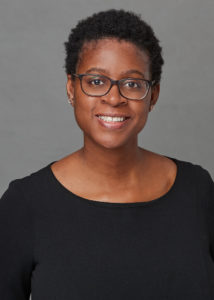
DeShun Harris
Assistant Clinical Professor of Law & Director of Bar Preparation
The University of Memphis Cecil C. Humphreys School of Law
Student-faculty interaction is an important component of law school. Indeed, LSSSE data indicate that the majority of students engage with faculty on matters other than coursework. In thinking about the many ways in which faculty engage with students whether in advising, academic support, mentoring, coaching, and office hours, it is important to consider how one-on-one meetings with students can be fruitful. As it relates to office hours specifically, because they are a requirement of the ABA, it’s important that think about the ways in which office hours can be conducive to learning and expand what is known about them.
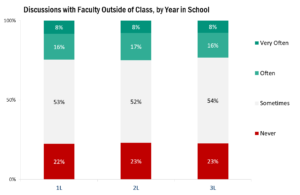
My research of office hours unveiled how to enhance office hours: overcoming underutilized office hours, creating a welcoming office, understanding the office hour framework, and creating a learner-centered collaborative environment. While much of the formal published article focuses on the framework of office hours and creating a learning-centered environment, for readers here, I think it’s important to focus on overcoming underutilized office hours and creating a welcoming office. In other words, let’s think about how students are encouraged to attend office hours. This becomes of particular importance to ensure some students aren’t missing out on critical faculty-student interactions. It is important, given the changing times, that one considers how the office hour might be adapted especially when we return for Fall 2020.
Encouraging Attendance: Invite Students Directly
Students have perceptions about office hours that are often the result of past experience or perceptions of their professor. For example, some students may believe office hours are only for students who are struggling. Some other students may believe professors are unapproachable or unavailable. There are many reasons why students may choose not to attend office hours even when they may be beneficial. With many students returning or beginning law school remotely, breaking down those perceptions is going to be very important when other types of faculty-student interaction might be reduced or changed (e.g., talking to students immediately after class, bumping into students in hallways, or chatting with students at events). This will make engaging some students in the office hour more important.
Professors can address these perceptions and circumstances by being intentional about inviting students to their office hours. For example, place a statement in the syllabus that explains the purposes of office hours (e.g., to ask questions, to explore ideas beyond the scope of class, to strengthen their analytical skills, or to learn more about the profession). Professors can reaffirm office hours by inviting students to visit periodically through the semester by expressing it during lectures or through emails or postings to the learning management system. My research also indicates that giving meaningful feedback can be a useful way of increasing the usage of office hours by students even more so than creating a welcoming environment; as professors think about assessments, they may find more students come as they provide feedback.
The Office Setting: Make it Comfortable
While it may be a while for some law schools to begin in-person teaching, when it does begin professors should be aware that the physical office sends implicit messages to students. A messy office with papers strewn about can communicate busyness and that the student is taking up valuable time. An office that creates a great deal of space between student and professor can communicate a clear divide between the two, making it difficult for the student to share honestly. Finally, for some students, coming to a physical office can be intimidating or less accessible.
Professors can make their offices and themselves appear more accessible by minimizing clutter, minimizing computer screens, and silencing phones. These small steps can help the student feel invited rather than feeling they are a distraction. To the extent possible, professors should structure their offices in a way that communicates collaborations rather than a hierarchical barrier between professor and student. Where it isn’t possible to close spacing due to social distancing, alternatives can include situating one’s self side by side or sitting at a round table to keep an appropriate distance but feeling closer or collaborative.
Alternatives to the Office: Online Options Work Too
This past semester, many professors learned that the physical office hour isn’t the only way to meet students. Using email or instant messaging can be a good way to reach those students who may be unable to attend physical office hours. But research suggests that email can sometimes be read with unfavorable biases toward minorities and women. It is important to create clear policies for the appropriate use of email to avoid unyielding chains of emails or questions that may be more appropriate for discussion. Professors may also create policies related to when emails will be answered to alleviate the stress of feeling a need to respond.
Phone calls and videoconferencing are great tools that if used properly can replicate the in-person office hours. More research is needed to evaluate the best practices for doing so, but professors should think about what they are asking of students if they request students to appear on screen (for some students it could be breaking a barrier between home and professional life that they aren’t willing to cross due to shame or privacy concerns). And meeting students in locations other than one’s office like common spaces can also serve to break down barriers and create more accessibility. Alternatively, professors may consider reserving larger spaces that allow groups of students to meet with the professor which may also reduce any barriers the student may have.
Conclusion
Office hours are an important part of student-faculty interactions. Professors might consider ways in which they can enhance office hours and make them more available and welcoming to their students. With the changes brought by COVID-19, it is now more important that professors evaluate the ways in which they adapt online versions of our office hours or meetings we have with students, and also give thought to what future in-person office hours might look like.
___
References:
DeShun Harris, Office Hours Are Not Obsolete: Fostering Learning Through One-on-One Student Meetings, 57 Duquesne L. Rev. 43 (2019).
ABA Standard 404(a) (1), http://www.americanbar.org/content/dam/aba/publications/misc/legal_education/Standards/2016_2017_standards_chapter4.authcheckdam.pdf.
Looking Ahead: Assessment in Legal Education Annual Results 2014, http://lssse.indiana.edu/wp-content/uploads/2016/01/LSSSE_2014_AnnualReport.pdf.
Rosemarie Arbur, The Student-Teacher Conference, 28 College Composition and Communication 338 (1977).
Elaine S. Barry, Using Office Hours Effectively, Observer, June/July 2008.
Whitney Griffin, et. al, Starting the Conversation: An Exploratory Study of Factors That Influence Student Office Hour Use, 62 College Teaching 94 (2014).
Mario Guerrero and Alisa Beth Rod, Engaging in Office Hours: A Study of Student-Faculty Interaction and Academic Performance, 9 Journal of Political Science Education 403 (2013).
Lydia Eckstein Jackson and Aimee Knupsky, “Weaning off of Email”: Encouraging Students to Use Office Hours over Email to Contact Professors, 63 College Teaching 183 (2015).
Robin S. Wellford-Slocum, The Law School Student-Faculty Conference: Towards A Transformative Learning Experience, 45 S. Tex. L. Rev. 255, 262 (2004).


